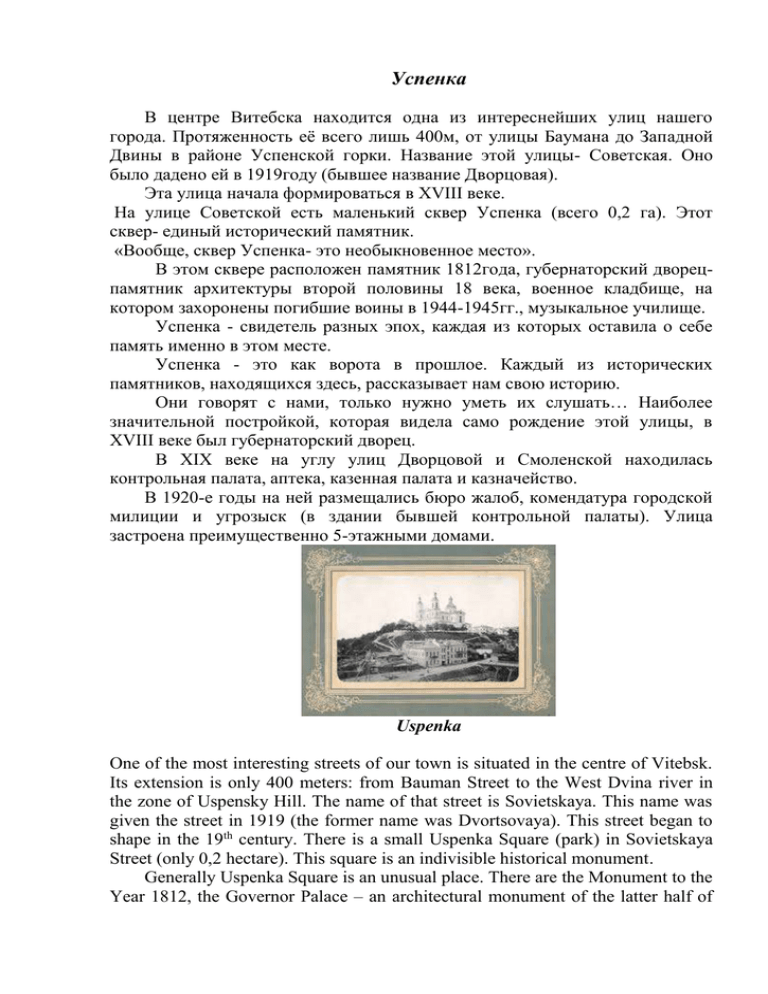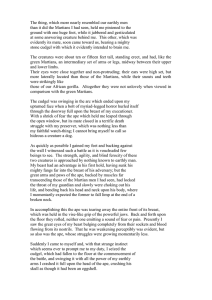One of the most interesting streets of our town is situated in the
advertisement

Успенка В центре Витебска находится одна из интереснейших улиц нашего города. Протяженность её всего лишь 400м, от улицы Баумана до Западной Двины в районе Успенской горки. Название этой улицы- Советская. Оно было дадено ей в 1919году (бывшее название Дворцовая). Эта улица начала формироваться в XVIII веке. На улице Советской есть маленький сквер Успенка (всего 0,2 га). Этот сквер- единый исторический памятник. «Вообще, сквер Успенка- это необыкновенное место». В этом сквере расположен памятник 1812года, губернаторский дворецпамятник архитектуры второй половины 18 века, военное кладбище, на котором захоронены погибшие воины в 1944-1945гг., музыкальное училище. Успенка - свидетель разных эпох, каждая из которых оставила о себе память именно в этом месте. Успенка - это как ворота в прошлое. Каждый из исторических памятников, находящихся здесь, рассказывает нам свою историю. Они говорят с нами, только нужно уметь их слушать… Наиболее значительной постройкой, которая видела само рождение этой улицы, в XVIII веке был губернаторский дворец. В XIX веке на углу улиц Дворцовой и Смоленской находилась контрольная палата, аптека, казенная палата и казначейство. В 1920-е годы на ней размещались бюро жалоб, комендатура городской милиции и угрозыск (в здании бывшей контрольной палаты). Улица застроена преимущественно 5-этажными домами. Uspenka One of the most interesting streets of our town is situated in the centre of Vitebsk. Its extension is only 400 meters: from Bauman Street to the West Dvina river in the zone of Uspensky Hill. The name of that street is Sovietskaya. This name was given the street in 1919 (the former name was Dvortsovaya). This street began to shape in the 19th century. There is a small Uspenka Square (park) in Sovietskaya Street (only 0,2 hectare). This square is an indivisible historical monument. Generally Uspenka Square is an unusual place. There are the Monument to the Year 1812, the Governor Palace – an architectural monument of the latter half of the 18th century, the Military Cemetery (where perished warriors were buried in 1944-1945) and the Musical School. Uspenka is a witness of different epochs; each of them left behind itself a trace here. Uspenka is like the gate in the past. Each of historical monuments lying here tells us its own story. They speak with us; all one need to do is to be able to listen to them… The most important building which saw the birth of this street in the 18th century is the Governor Palace. In the 19th century there were the Chamber of Control, a drugstore, the State Chamber and the Treasure at the corner of Dvortsovaya Street and Smolenskaya Street. In the 19th century the Complain Bureau, the Commandant’s Office of Municipal Police and the Criminal Investigation Department were placed in it. The street is built up mainly with fivestory houses. МУЗЫКАЛЬНОЕ УЧИЛИЩЕ Витебское музыкальное училище Министерства культуры БССР(ул.Советская,23а). Основано в 1918 как Народная консерватория, в 1919-специальная музыкальная школа 3 ступеней, с 1922-музыкальный техникум, с 1927-профессионально-техническая школа, с 1935-музыкальное училище. В 1923 открыто хореографическое отделение, в 1924-оперный класс. В годы Великой Отечественной войны училище разрушено. Восстановлено в 1947. В 1986/87 учебном году специальности: фортепьяно, струнные инструменты, духовые и ударные инструменты, народные инструменты, хоровое дирижирование, теория музыки. Принимаются лица, окончившие 8 и 10 классов. Обучение дневное. Училище оснащено музыкальными инструментами техническими средствами обучения. За 19501986 в училище подготовлено 1,9 тыс. специалистов. Ежегодно в колхозах, госхозах, на предприятиях и в учебных заведениях города учащиеся училища дают до 100 концертов. The Musical School The Musical School was founded in 1918 as the People’s Conservatory, in 1919 it was (by some documents) the Special Musical School with three levels, since 1922 – the Musical Secondary School, since 1927 – the Trade School, since 1933 – the Musical School. In 1923 appeared a choreographic section and an opera form. During the Great Patriotic War the school was destroyed. It was renewed in 1947. In 1986/87 there were the following sections in this school: Piano, String Instruments, Wind and Percussion Instruments, Folk Instruments, Choral Conducting, Theory of Music. The school is equipped with musical instruments, technical means of teaching. Every year the students of this school arrange about 100 concerts. МУЗЕЙ МАРКА ШАГАЛА Шагал провёл свои юные годы на улице Покровская в доме, который был построен отцом художника в начале 1990-х. Об этом периоде своей биографии он написал в своей автобиографической книге «Моя жизнь». Музей был открыт в 1997 году. В нем представлены предметы домашнего обихода 19-20 вв., а также копии архивных документов и работы Шагала, рассказывающие о его собственной жизни и жизни его родителей в Витебске. Дни Шагала проводятся в Витебске с начала 1991 года. Их программа включает Шагаловские чтения, презентации выставок, музыкальные фестивали, праздник на Покровской улице и другие мероприятия. Первые лекции, посвященные Марку Шагалу, были прочитаны на Всесоюзных Шагаловских чтениях в январе 1991 года. С 1992 года Шагаловские чтения стали международными. В течение этих лет больше чем 60 научных сотрудников из Беларуси, России, Украины, Франции, Великобритании и других стран приняли в них участие. The Marc Chagall Museum M. Chagall spent his youthful years in Pokrovskaya Street in the house which was built by the father of the painter at the beginning of the 1900 th. About this period of his biography he wrote in his autobiographical book “My Life”. The museum was opened in 1997. The household goods from the 19 th and 20th centuries are displayed there; as well as the copies of archival documents and Chagall’s works telling about his own life and life of his parents in Vitebsk. Chagall Days have been arranged in Vitebsk since beginning of 1991. Their program includes Chagall Readings, representations of exhibitions, musical festivals, holiday in Pokrovskaya Street and other actions. The first lectures dedicated to Mark Chagall were read at the All-Union Chagall Reading in January 1991. Since 1992 Chagall Reading have become international one; during these years more than 60 research workers from Belarus, Russia, the Ukraine, France, Great Britain and other countries took part in it. ВОЕННОЕ КЛАДБИЩЕ В Витебске два Военных кладбища. Одно из них находится по ул. Советской, на Успенской горке. Захоронено 15 советских воинов, погибших в Великую Отечественную войну, в то числе Герои Советского Союза И.П.Сиваков, И.И.Янушковский ,а также М.Ф.Шмырев. 11 одиночных могил и 1 братская,в которой захоронены 4 воина, погибшие в 1944-1945г. На могилах установлены надгробные плиты с именами захороненных. В 1956 на кладбище установлены 2 скульптуры воинов. The Military Cemetery There are two military cemeteries in Vitebsk. One of them is situated in Sovietskaya Street. Four warriors perished in 1944-1945 are buried there as well as the Heroes of Soviet Union: I. Sivakov, M. Shmyryev, I.Yanushevsky. Altogether 15 men are buried in Uspensky Hill. Eleven single graves and one common grave are situated in this cemetery. The grave stones with the names of the buried are placed there. In 1956 two sculptures of warriors were placed there too. ДВОРЕЦ ГУБЕРНАТОРА (сейчас здание КГБ) Памятник архитектуры классицизма 2-ой половины 18-нач.19 века. Построен в последней четверти 18 века на высоком берегу Западной Двины как городской особняк. В 1806 куплен для переоборудования под дворец генерал-губернатора. Состоит из 2 корпусов: основного(северного) 3- этажного прямоугольного в плане и примыкающего к нему 2-этажного Побразного. Главный фасад основного корпуса выходит на сквер с памятником героям Отечественной войны 1812, выделен ризалитом и 4 полуколоннами дорического ордера, поддерживающими балкон. Боковой фасад, ориентированный к Западной Двине, украшен 4-колонным портиком. Такой же портик замыкает главный фасад 2-этажного корпуса. Окна прямоугольные. Фасады отделаны руслом, завершены развитым карнизом и аттиками. На 1-м этаже основного корпуса в центре находится парадный вестибюль с лестницей и комнаты прислуги ,на 20м-приемная,гостиная и кабинет губернатора,3-й отводился под жильё. В 2-этажном корпусе на 1-м этаже были служебные комнаты управления и канцелярии губернатора ,на 2м-столовая,приспособленная для концертов и спектаклей, в торцовой частицерковь. Здание несколько раз перестраивалось, первоначальная планировка изменена. Был резиденцией генерал-губернаторов и губернаторов. В 1812 году был дворцом и штаб-квартирой Наполеона. The Governor’s Palace (now is the building of KGB) It is an architectural monument of classicism of latter half of the 18th and the beginning of the 19th centuries. It was built on the high bank of the West Dvina river as a villa in the last quarter of the 18th century. In 1806 it was bought as the palace for a governor-general. It consists of two buildings: of a main (north) three-story rectangular building and an adjacent twostory U-shaped one (built in 1811). The principal front of the main building looks on the square with the monument to the heroes of the Patriotic War 1812; it is marked out with risalith and four semi columns of Doric order supporting balcony. The side elevation oriented to the West Dvina river is decorated with four columned portico. The same portico closes the principle front. The windows are right-angled. The principle front and the side elevations are decorated with rustics, enclosed with complex cornices and attics. There were a gala vestibule with stairs and servant-rooms on the ground floor of the main building. A waiting-room, a drawing-room and the governor cabinet were situated on the first floor; the second floor was intended for habitation. In the two-story building there were office-rooms, the chancellery department of the governor on the ground floor, a dining room fit for concerts and performances and a church in the trade part. The building was rebuilt several times; the original planning was changed. This palace was the residence of governor-generals and governors. In 1812 it was the palace and the headquarters of Napoleon. ПАМЯТНИК ГЕРОЯМ ОТЕЧЕСТВЕННОЙ ВОЙНЫ 1812 ГОДА Установлен в 1912(ул. Советская) в память о русских воинах , проявивших мужество и стойкость в боях под Витебском 13-15.7.и 26.10.1812,по инициативе Витебской ученой архивной комиссии на средства, собранные жителями города и губернии. Строительными работами руководил витебский городской архитектор Кибардин. Четырехгранный обелиск(высота 26 м),увенчанный бронзовым двуглавым орлом на шаре, установлен на частично расчлененном прямоугольном пьедестале. Обелиск от пьедестала отделяют 4 небольших угловых блока с просветами между ними. На вертикальной плоскости пьедестала плита с надписью: «Бессмертной доблести героев Отечественной войны, участников сражений под Витебском 13,14, 15 июля и 26 октября 1812 года». По углам плиты-основания установлены 4 чугунные пушки, отлитые по образцам мортир времен Петра I. The Monument to the Heroes of the Patriotic War 1812 It was placed in 1912 (Sovietskaya Street) in memory of the Russian warriors who showed courage and steadfastness in the battles near Vitebsk on July 13-17 and on October 26 in 1812. It was built by initiative of Vitebsk scientific archival commission thanks to the means collected by inhabitants of the town and the province (the project by I. Fomin; red granite). Construction work was directed by municipal architect Kibardin. The tetrahedral obelisk (height – 26 meters) topped with the double eagle on sphere is placed on the partly-partitioned right-angled pedestal. The obelisk is separated from the pedestal by four small corner blocks with gaps between them. On the vertical plate of the pedestal there is a slab with inscription: “To undying valor of the heroes of the Patriotic War taken part in the battles near Vitebsk on July 13, 14, 15 and October 26 1812”. In the corners of ground plate are placed four cast-iron cannons founded per samples of mortars made in Peter’s I time (before the Great Patriotic War there were cannon-balls in threes about 40 cm in diameter near each cannon). The Monument to the Heroes of the Patriotic War 1812 is situated in the place where Spasskaya Church stood and burned down later. In 1810 a stone temple was built in its place but destroyed by order of Napoleon.
